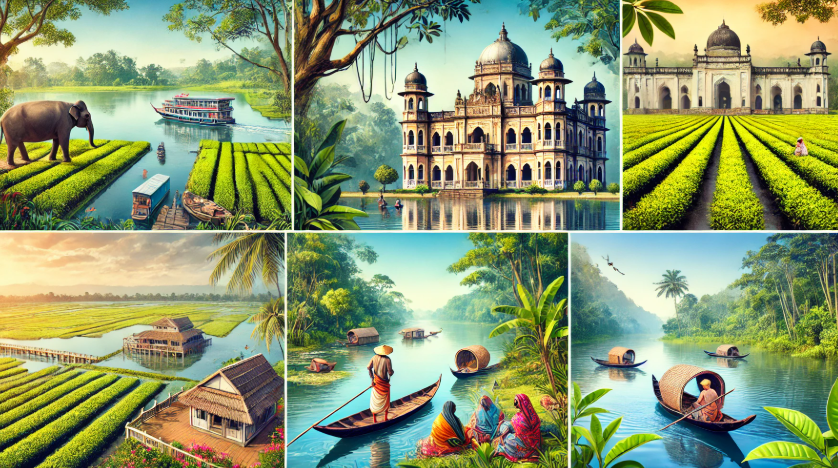Nestled in the northeastern region of Bangladesh, Moulvibazar is a captivating district within the Sylhet division. Known for its rolling tea gardens, serene wetlands, rich biodiversity, and vibrant cultural tapestry, it stands as one of the most picturesque and historically significant areas in the country. From its verdant hills to its bustling bazaars, Moulvibazar offers a blend of natural splendor, cultural diversity, and historical depth that leaves visitors in awe.
A Glimpse into History
The name “Moulvibazar” originates from Moulvi Syed Qudratullah, a revered Muslim saint who established a market in the region during the 18th century. The area flourished under his influence and subsequently grew into a prominent administrative and commercial hub. Its historical roots trace back to the Mughal era, and remnants of British colonial architecture also dot the landscape, reflecting its multifaceted past.
Administrative Divisions of Moulvibazar
Moulvibazar district is divided into seven upazilas, each offering a unique array of attractions and experiences:
- Moulvibazar Sadar:
- The administrative center of the district.
- Hosts vibrant bazaars, cultural institutions, and historical mosques.
- Srimangal:
- Known as the “Tea Capital of Bangladesh.”
- Home to the famous Lawachara National Park and Baikka Beel Wetland.
- Kamalganj:
- A treasure trove of natural wonders like Madhabkunda Waterfall.
- Rich in cultural heritage, including Khasi and Manipuri communities.
- Kulaura:
- Features vast haors (wetlands) like Hakaluki Haor, a biodiversity hotspot.
- Offers glimpses of rural life and agricultural practices.
- Rajnagar:
- Known for serene landscapes and traditional crafts.
- Historical sites include old zamindar mansions.
- Juri:
- Predominantly rural, showcasing the simplicity of agrarian life.
- Rich in natural resources and greenery.
- Barlekha:
- Borders the Indian state of Assam.
- Known for its diverse ecosystems and indigenous communities.
Major Attractions in Moulvibazar
1. Lawachara National Park

A UNESCO-declared eco-park, Lawachara National Park is an ecological treasure trove. Spanning over 1,250 hectares, it houses an incredible variety of flora and fauna, including rare species like the hoolock gibbon, clouded leopard, and pygmy hog. The park offers well-marked trails, making it ideal for hiking and birdwatching.
2. Srimangal’s Tea Estates
The undulating tea gardens of Srimangal are a sight to behold. Stretching as far as the eye can see, the estates produce some of the finest tea in Bangladesh. Visitors can tour the plantations, learn about the tea-making process, and sample freshly brewed aromatic tea.
3. Hakaluki Haor
Covering an area of nearly 40,000 hectares, Hakaluki Haor is one of the largest wetlands in South Asia. It serves as a sanctuary for migratory birds and an important source of livelihood for local fishermen. Boating through the haor during the monsoon season is an unforgettable experience.
4. Madhabkunda Waterfall

Located in the Kamalganj upazila, Madhabkunda is the highest waterfall in Bangladesh. Surrounded by lush greenery and rocky terrain, it is a favorite spot for picnics and nature photography.
5. Manipuri and Khasi Villages
The indigenous Manipuri and Khasi communities in Moulvibazar have preserved their traditional ways of life for centuries. Visitors can explore these villages to witness their unique architecture, vibrant festivals, and handicrafts.
6. Baikka Beel Wetland Sanctuary
A paradise for bird enthusiasts, Baikka Beel is a protected area within the Srimangal upazila. It attracts migratory birds like herons, ducks, and storks during the winter months, offering a tranquil setting for birdwatching.
7. Bholagonj Stone Quarry

Located near the Indian border, this natural stone quarry is a marvel of scenic beauty. Crystal-clear waters, green hills, and a serene atmosphere make it a popular destination for day trips.
Cultural and Culinary Diversity
Moulvibazar is a cultural melting pot, home to Bengali Muslims, Khasi, Manipuri, and Tripuri communities. This diversity is reflected in the district’s festivals, rituals, and cuisine.
- Festivals: Major events include the Khasi harvest festival and Manipuri Ras Lila.
- Cuisine: Traditional dishes like pitha (rice cakes), Khasi smoked meat, and fish curry made from haor fish are must-tries.
Economy and Livelihood
The economy of Moulvibazar is primarily driven by agriculture, tea production, and tourism. The tea estates are the largest employers, while the wetlands support fishing and rice cultivation. Handicrafts made by indigenous communities also contribute significantly to the local economy.
Why Visit Moulvibazar?
Moulvibazar offers an unparalleled mix of natural beauty, cultural diversity, and historical intrigue. Whether you’re an adventurer, a history buff, or a nature lover, the district has something for everyone. From trekking through dense forests to sipping tea amidst verdant hills, Moulvibazar provides experiences that are both enriching and rejuvenating.
Conclusion
Moulvibazar is more than just a district—it’s a celebration of Bangladesh’s natural and cultural wealth. A visit here promises unforgettable memories, stunning landscapes, and a deeper appreciation of the country’s heritage. Plan your trip to Moulvibazar and immerse yourself in the serene charm and vibrant culture of this remarkable destination.



